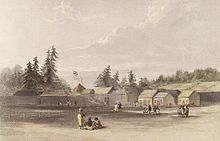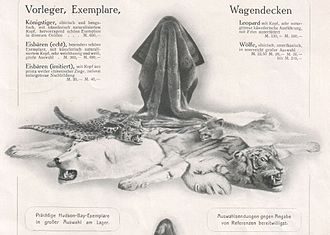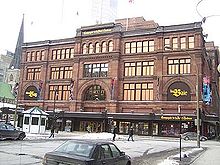Hudson's Bay Company
| Hudson's Bay Company Compagnie de la Baie d'Hudson
|
|
|---|---|
| legal form | Corporation |
| ISIN | CA4442181018 |
| founding | May 2, 1670 |
| Seat |
Toronto , Canada |
| management |
|
| Number of employees | 66,000 |
| sales | 14.455 billion CAD 10.273 billion EUR |
| Branch | retail trade |
| Website | www3.hbc.com |
| As of January 28, 2017 | |
The Hudson's Bay Company ( HBC , French Compagnie de la Baie d'Hudson ) is a Canadian trading company founded in 1670 with a privilege of the King of England, Scotland and Ireland .
The Hudson's Bay Company is the oldest registered company in Canada . From her long-standing headquarters in York Factory on Hudson Bay , she controlled the fur trade in large parts of British-ruled North America for several centuries . She made early explorations and acted as the de facto British government in many areas of the continent before large-scale colonization began. Their traders and fur hunters established relationships with many Indian groups at an early stage . Their network of trading posts formed the core of what would become official authorities in western Canada and the United States. In the late 19th century, their vast territory became the largest component of the newly formed Dominion Canada , in which society was the largest private landowner. During the decline of the fur trade at the time, the company developed into a trading company that sold essential goods to the settlers in western Canada. Today the company is known across Canada for its department stores under the Hudson's Bay brand .
history
Early years

In the 17th century, the French had a monopoly on the Canadian fur trade. However, two French traders, Pierre-Esprit Radisson and Médard des Groseilliers , switched to the English and reported a route to the rich trading areas north and west of Lake Superior , which could be reached from the north through Hudson Bay rather than by land New France from. The English sent a successful expedition in 1669.
On May 2, 1670, the Hudson's Bay Company - its full name was: Governor and Company of Adventurers of England trading into Hudson's Bay - was founded with a royal charter from Charles II . Its chairman was called the governor , and the shareholders were called proprietors . In their meetings, the general courts, they elected the governor, his deputy governor and the board of directors . The shares could only be sold with their approval and that of the governor, a provision that lasted until 1863. The charter granted the company a monopoly on Indian trade, particularly fur trade, in the area drained by the rivers that flow into Hudson Bay. This area became known as " Rupertsland ", named after the company's first director, Prince Ruprecht von der Pfalz . It covered 3.9 million km² in the Hudson Bay watershed - more than a third of what is now Canada - and extended to the north-west of the United States. However, the exact limits were unknown at the time.
The company established its first headquarters in Fort Nelson, later renamed York Factory, at the mouth of the Nelson River in what is now northeastern Manitoba . The site provided convenient access to the fort via the extensive river systems of the Saskatchewan and Red River (Rivière Rouge). More outposts were soon established on the south coast of Hudson Bay in Manitoba and what is now Ontario and Québec . They were called trading houses and worked in the manner of the Dutch fur traders in Nieuw Nederland . In spring and summer, the local traders, who did most of the actual trapping, came to the forts by canoe to sell their furs. In exchange for this, they were usually given metal tools and hunting weapons. The company often imported these from Germany, which at the time was the center for cheap production. This early model of offshore factories contrasted with the French system, who set up an extensive network of inland posts and sent out traders who lived with the local tribes.
The conservative structure of the trading system disappointed the company's founders, Radisson and Des Groseilliers, who urged bolder inland exploration. In 1674 they switched back to the French and founded La Compagnie du Nord in 1682 to compete directly with the HBC. After war broke out between England and France in Europe in the 1680s, both nations regularly sent expeditions to ambush and conquer the other's fur trading posts. In March 1686, under the Chevalier des Troyes, the French dispatched a raid over 1,300 miles to take the Society's outposts along James Bay . The French appointed Pierre Le Moyne d'Iberville to command the positions they had captured. In 1687, d'Iberville commanded a maritime raid on the company's headquarters at York Factory. On the way to the fort, he defeated three Royal Navy ships in the Battle of the Bay . This was the largest naval battle in the history of the North American Arctic. D'Iberville's exhausted French force captured York Factory with a ruse: he besieged the fort, creating the appearance of a much larger army. In the following decade, York Factory changed hands several times. With the Peace of Utrecht in 1713 it was finally ceded to the English. The company then rebuilt it as a star-shaped brick fort at the mouth of the nearby Hayes River . This is still its location today.
19th century


At the beginning of the 19th century, the Hudson's Bay Company began to change its character as a pure trading company. In 1811 she first bought land in the Assiniboine Basin in order to sell it to one of her shareholders, the Earl of Selkirk .
The Hudson's Bay Company was merged with the North West Company from Montréal in 1821 . Their common territory was expanded to include the Northwest Territories through a license . It reached the Arctic Ocean in the north and the Pacific Ocean in the west.
In the 1820s and 30s, the company controlled by its Headquarters Fort Vancouver on the Columbia from almost the entire trade in the Oregon Country , which, in spite of concerns, used alcohol as a lure for the Indian trappers. Although state authority over the area was nominally jointly exercised by the United States and Great Britain in accordance with the Anglo-American Agreement of 1818, it was the policy of the Society, under its director John McLoughlin, to actively discourage American settlement in the area. The company's effective trade monopoly forbade practically any settlement. In the early 1840s, she established an outpost at Fort Hall in present-day Idaho on the Oregon Trail route . The head of this outpost exhibited abandoned wagons belonging to discouraged settlers. The stranglehold of society around this region was broken by the first large wagon train to reach Oregon in 1843 under the leadership of Marcus Whitman. In the years that followed, thousands of settlers flocked to the Willamette Valley . In 1846, in the Oregon Compromise , the United States gained full power over most of the populated areas of the Oregon Country south of the 49th parallel. McLoughlin, who once turned away potential settlers as a company director, was now welcoming them from his Oregon City department store . He was later proclaimed "Father of Oregon". The company no longer has a branch in the Northwest of the USA.
The Company's monopoly of trade was also threatened by the Selkirk Colony's trade with the United States over the Red River Trails and was in fact broken by the mid-19th century. In 1836 the Company took over the land from Sir Selkirk and administered it until 1870. In that year the Company was compensated for the cession of its privileges in much of Canada with land surrounding its trading posts. For several decades it appeared mainly in the west as an agrarian society and acquired farmland through the Puget Sound Company .
Because of the earlier monopoly efforts, the suppression of all competition and the quasi-state appearance and self-image, the abbreviation "HBC" was / is mockingly ironically read by Canadians as "Here Before Christ".
In 1869, the company agreed to cede its Canadian territory, especially Rupertsland, to Canada in the so-called Deed of Surrender . In 1870 the trade monopoly was abolished and trade in this region was opened to every entrepreneur. In addition, the company lost Rupertsland, which was sold to the Canadian government.
Modern activities



One aspect of society was the Hudson's Bay Company stores , trading posts that had been set up across northern Canada. The last of eleven of these stores opened in Winnipeg in 1926. Today, this is (the only remaining part of the activities of the company, in the form of department stores that "The Bay" Engl. ) Or "La Baie" ( fr. Are called). Many of these stores were the only ones in remote locations until recently. Recently, many of these stores have been converted into boutiques. In 1991, after protests by animal rights activists, the Bay stopped selling fur, but resumed this line of business in 1997. Animal rights groups like Freedom for Animals are campaigning to stop the sale again.
In the years between around 1920 and 1980, HBC was also involved in raw materials trading, especially oil, and in land trading. In 1939, the HBC even tried air transport by purchasing its first aircraft. The maritime trade with own ships, which had been operated since the voyage of the Nonsuch in 1668, was given up in 1987 when the MV Kanguk was sold.
In the 1980s, the Hudson's Bay Company was 74% owned by the newspaper magnate Kenneth Thomson, 2nd Baron Thomson of Fleet , who had shifted the trading company's economic activities more into the energy and real estate businesses. In 2006, Jerry Zucker acquired the company for $ 1.1 billion and took it off the stock exchange. After his death in 2008, it was sold to NRDC Equity Partners by his widow Anita Zucker . In 2012 the company was listed on the stock exchange again.
In June 2015, the German retail group Metro Group announced that it would sell its Kaufhof department store chain to the Hudson's Bay Company in September 2015 . According to the announcement, the agreement includes the department store business, which operates primarily under “Galeria Kaufhof” in Germany and “ Galeria Inno ” in Belgium , as well as the associated properties. The purchase price was given as EUR 2.8 billion.
In July 2017 it became known that the Euler Hermes trade credit insurance company had drastically reduced the default guarantees for Galeria Kaufhof. The German Manager Magazin speaks of "a crisis that can quickly escalate."
In September 2018 it became known that the Hudson's Bay Company wanted to bring the ailing department store chain Galeria Kaufhof into a joint venture with the Austrian Signa Holding , which had already successfully restructured the insolvent Karstadt department store chain in previous years. The merger was later approved and implemented by the competition authority. The new joint venture between Signa and Hudson's Bay Company (HBC), in which Signa held a majority stake of 50.01%, included Galeria Kaufhof , Karstadt Warenhaus GmbH , the entire retail business of HBC Europe (Saks OFF 5TH, Galeria Inno in Belgium, Hudson's Bay in the Netherlands) and Karstadt Sports as well as the entire food and catering sector of both companies belong. On June 10, 2019, HBC announced that it would sell its stake in the joint venture for $ 1.5 billion to Signa Holding, which will become the sole owner. The transaction is expected to be completed by autumn 2019.
Governors
- Ruprecht von der Pfalz, Duke of Cumberland (1670–1682)
- Prince James, Duke of York (1683–1685)
- John Churchill, Earl of Marlborough (1685–1692)
- Stephen Evans (1692-1696)
- William Trumbull (1696-1700)
- Stephen Evans (1700-1712)
- Bibye Lake, Sr. (1712-1743)
- Benjamin Pitt (1743–1746)
- Thomas Knapp (1746–1750)
- Atwell Lake (1750-1760)
- William Baker (1760-1770)
- Bibye Lake, Jr. (1770-1782)
- Samuel Wegg (1782–1799)
- James Winter Lake (1799-1807)
- William Mainwaring (1807-1812)
- Joseph Berens (1812-1822)
- John Henry Pelly (1822-1852)
- Andrew Wedderburn Colvile (1852-1856)
- John Shepherd (1856-1858)
- Henry Hulse Berens (1858–1863)
- Edmund Walker Head (1863-1868)
- John Wodehouse, 1st Earl of Kimberley (1868–1869)
- Stafford Henry Northcote (1869-1874)
- George Joachim Goschen (1874–1880)
- Eden Colvile (1880-1889)
- Donald Smith, 1st Baron Strathcona and Mount Royal (1889–1914)
- Thomas Skinner (1914-1915)
- Robert Molesworth Kindersley (1916-1925)
- Charles Vincent Sale (1925-1931)
- Patrick Ashley Cooper (1931-1952)
- William Keswick (1952-1965)
- Derick Heathcoat-Amory, 1st Viscount Amory (1965–1970)
- George T. Richardson (1970-1982)
- Donald S. McGiverin (1982-1994)
- David E. Mitchell (1994-1997)
- L. Yves Fortier (1997-2006)
- Jerry Zucker (2006-2008)
- Anita Zucker (2008)
- Richard Baker (since 2008)
See also
- Hudson's Bay Company Archives
- British East India Company
- History of Canada
- Dutch East India Company (VOC)
- Dutch West India Company
- List of the world's oldest companies
literature
- Martin Hunter: American Indian Treaties: Canadian Wilds: Tells About the Hudson's Bay Company, Northern Indians and Their Modes of Hunting, Trapping, Etc. , AR Haring, Columbus (Ohio) 1907 Digitized edition
- Sylvia van Kirk: Many Tender Ties: Women in the Fur-Trade Society 1670-1870. University of Oklahoma Press , Norman 1980, frequent Neuaufl., In Google books visible
- Olive Patricia Dickason: Canada's First Nations . A history of founding peoples from earliest times. University of Oklahoma Press, Norman 1992
- William John Eccles: The Canadian frontier 1534-1760. University of New Mexico Press, Albuquerque 1983
- Arthur J. Ray: Indians in the fur trade. Their role as trappers, hunters, and middlemen in the lands southwest of Hudson Bay 1660-1870. University of Toronto Press, 1974
Web links
- Official Hudson's Bay Company website (English, French)
- North West Company, founded in 1987
- Manitoba Government Hudson's Bay Company Archives
- Hudson's Bay Company ( English, French ) In: The Canadian Encyclopedia .
- Entry in the Washington encyclopedia HistoryLink (English)
- "The Leviathan of the North": American Perceptions of the Hudson's Bay Company, 1816-1846 ( November 30, 2004 memento on the Internet Archive ) by William R. Swagerty. In: Oregon Historical Quarterly , Winter 2003 Edition
- Early documents and newspaper articles on the Hudson's Bay Company in the 20th century press kit of the ZBW - Leibniz Information Center for Economics .
Individual evidence
- ↑ a b Hudson's Bay Company 2016 Annual Report , accessed August 9, 2017
- ↑ Converted at the rate on the balance sheet date January 28, 2017
- ^ Letter from George Simpson, Governor of the Hudson's Bay Company, to Andrew Colvile, member of the Governing Committee in London, May 20, 1822
- ↑ The archives of the Hudson's Bay Company held an exhibition on this until November 2007 ( A new Store for an old Company ).
- ↑ Press release on the Hudson's Bay website , accessed June 15, 2015
- ↑ What makes this crisis so dangerous Wirtschaftswoche on July 27, 2017
- ↑ Signa creates new department store giant ( Memento from November 16, 2018 in the Internet Archive ), Wiener Zeitung from September 11, 2018, accessed on March 3, 2019
- ↑ investor.hbc.com/news-releases/news-release-details/hbc-agrees-sell-remaining-european-real-estate-and-divest



